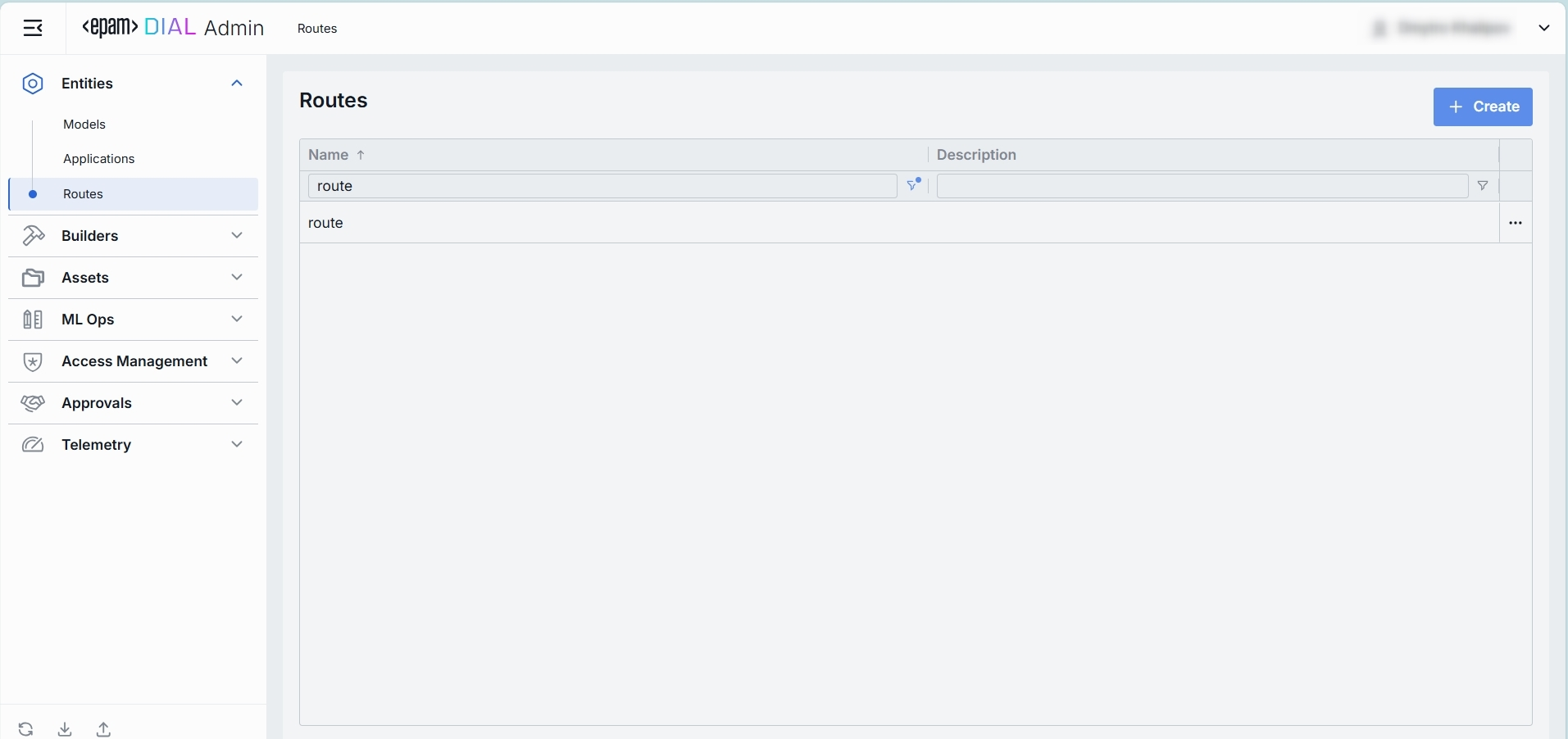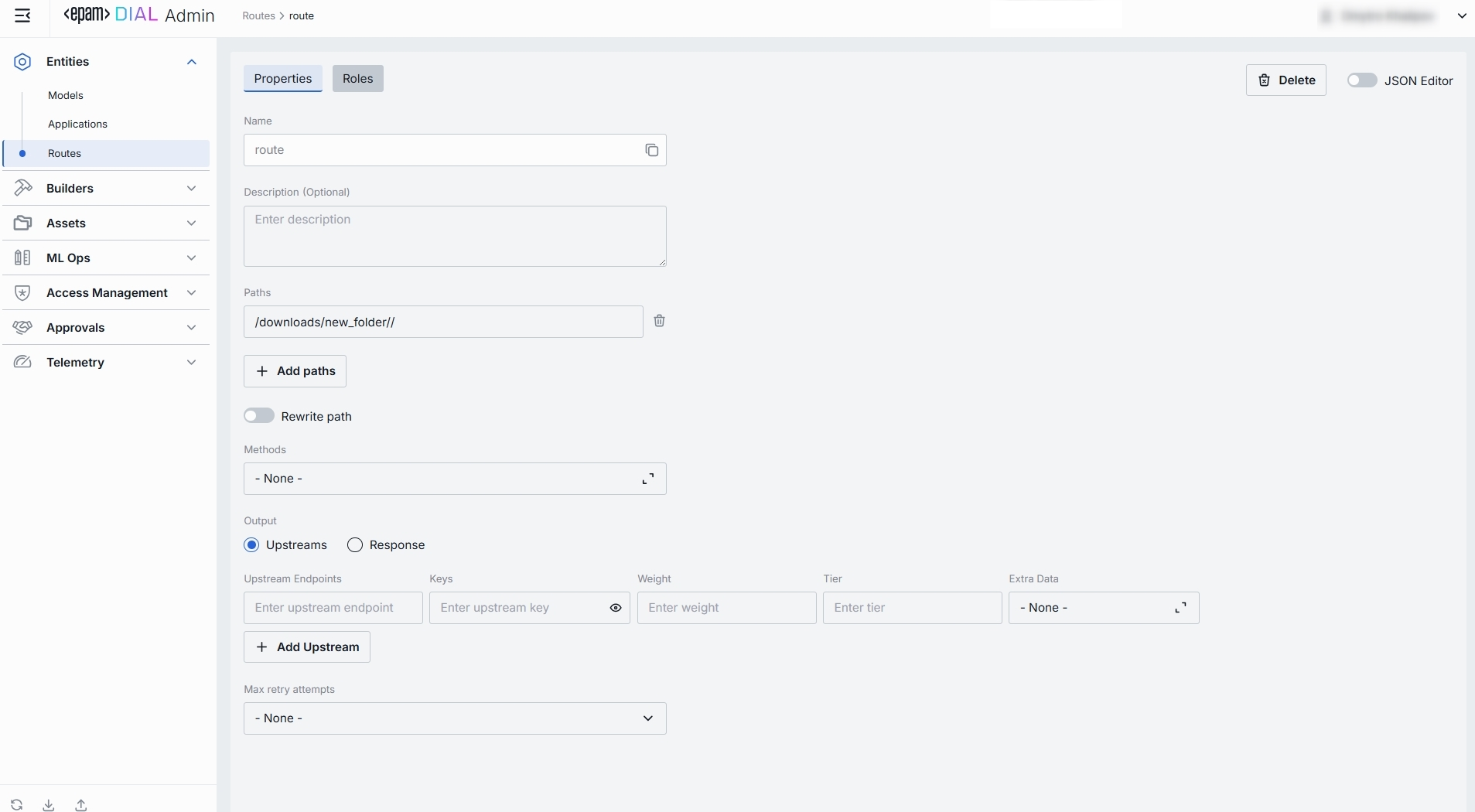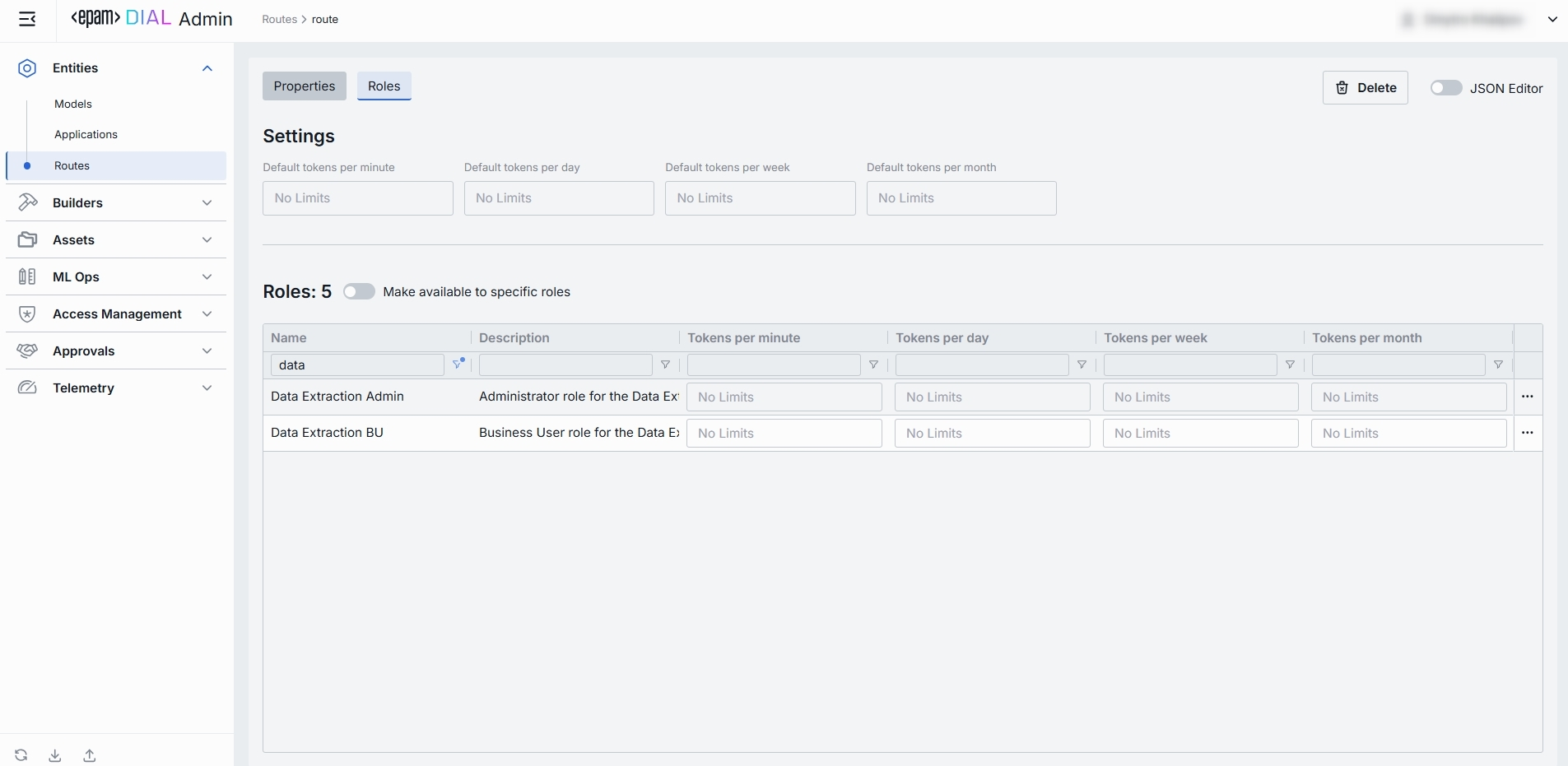Routes
About Routes
Routes in DIAL are used for communication through registered endpoints in the DIAL Core. They act as a bridging mechanism between the DIAL Core and external applications, facilitating seamless interactions. Once a route with a designated endpoint is set up in DIAL Core, it allows client applications, such as DIAL Chat, to interact with this endpoint. Essentially, DIAL Core functions as an intermediary, handling authentication and authorization between the client and the external application linked to the route.
Routes List
In Routes, you can view, filter, and create new routes.

Routes grid
| Field | Definition |
|---|---|
| Name | A user-friendly name of the Route. |
| Description | A brief free-text description of the Route's purpose. |
Create
-
Click + Create to invoke the Create Route modal.
-
Define rout's parameters
Field Required Definition Name Yes A user-friendly name of the Route. Description No A brief free-text description of the Route’s purpose. Paths Yes URL path(s) pattern this route should match (e.g. /chat,/support/). -
Once all required fields are filled, click Create. The dialog closes and the new route configuration screen is opened. This entry will appear immediately in the listing once created. It may take some time for the changes to take effect after saving.

Route Configuration
Top Bar Controls
- Delete: Permanently removes the selected route. Any client calls to this path will return 404 until a new route is created.
- JSON Editor (Toggle): Switch between the form-based UI and raw JSON view of the route’s configuration. Use JSON mode for copy-paste or advanced edits.
Properties
In the Properties tab, you can define the identity and routing behavior.

Basic Identification
| Field | Required | Definition |
|---|---|---|
| Name | Yes | A unique route key used in the URL and dynamic settings of DIAL Core (e.g. chat, support). |
| Description | No | Free‐text note about the route’s purpose (e.g. “Primary GPT-4 chat with fallback”). |
Request Matching: Paths & Methods
| Field | Required | Definition |
|---|---|---|
| Paths | Yes | One or more URL path patterns this route should match (e.g. /chat, /support/**). Click + Add paths to register additional patterns. Click the trash icon to remove a path. |
| Rewrite path | No | Toggle on to strip or transform the incoming path before forwarding upstream. Use when your upstream service expects a different URL structure (e.g. remove /api/v1/routes/chat prefix). |
| Methods | No | Select one or more HTTP methods (GET, POST, PUT, DELETE, etc.) the route can accept. |
Output Mode
Use the output mode to define the response of a Route.
| Option | Definition |
|---|---|
| Upstreams | Add and configure upstreams to forward matching requests to one or more upstream endpoints (Models or Applications). Refer to Upstream Configuration. |
| Response | Use to return a static, pre-defined payload. Useful for health checks or mock responses. Refer to Response Configuration. |
Upstream Configuration
Define where and how to forward requests when the Upstreams output mode is selected.
| Field | Required | Description & Use Case |
|---|---|---|
| Upstream Endpoints | Yes | Full URL(s) of the back-end service(s) to receive the routed request (e.g. https://dial-core.example.com/v1/chat). |
| Keys | No | API key or token to attach (via header or query) when calling the upstream. Click the eye icon to reveal a masked value. |
| Weight | No | Relative traffic weight for load balancing among multiple endpoints (higher = more traffic). |
| Tier | No | Specifies an endpoint group. In a regular scenario, all requests are routed to endpoints with the lowest tier, but in case of an outage or hitting the limits, the next one in the line helps to handle the load. Refer to load balancing to learn more. |
| Extra Data | No | Select a JSON BLOB from Assets → Files to attach as metadata for the upstream adapter. |
| + Add Upstream | — | Append additional endpoints for failover or capacity scaling. |
Response Configuration
Define where and how to forward requests when Response mode is selected:
| Field | Required | What It Does |
|---|---|---|
| Status | No | The HTTP status code your route will return (e.g. 200, 404, 503). |
| Body | No | The exact payload to send in the response body. You can enter plain text or raw JSON. |
| Max retry attempts | No | (Optional) Determines how many times DIAL will retry the static‐response logic on internal errors. |
Roles
In the Roles tab, you can define user groups that can invoke this route and define rate limits for them.

Roles grid columns:
| Column | Description & Guidance |
|---|---|
| Name | A unique role identifier. |
| Description | A user-friendly description of the role (e.g., "Admin, Prompt Engineer, Developer"). |
| Tokens per minute | Per Minute tokens limit for a specific role. Blank = no limits. Inherits the default value. Can be overridden. |
| Tokens per day | Daily tokens limit for a specific role. Blank = no limits. Inherits the default value. Can be overridden. |
| Tokens per week | Weekly tokens limit for a specific role. Blank = no limits. Inherits the default value. Can be overridden. |
| Tokens per month | Monthly tokens limit for a specific role. Blank = no limits. Inherits the default value. Can be overridden. |
| Actions | Additional role-specific actions. Open Roles section in a new tab. Make all restrictions unlimited for the given role |
Set Rate Limits
The grid on the Roles screen lists the roles that can access a specific route. Here, you can also set individual limits for selected roles. For example, you can give "Admin" role unlimited monthly tokens but throttle "Developer" to 100,000 tokens/day or allow the "External Partner" role a small trial quota (e.g., 10,000 tokens/month) before upgrade.
To set or change rate limits for a role:
- Click in the desired cell (e.g., Tokens per day for the “ADMIN”).
- Enter a numeric limit or leave blank to set no limits. Click Reset to default limits to restore default settings for all roles.
- Click Save to apply changes.
Default Rate Limits
Default limits are set for all the roles in the Roles grid by default; however you can override them for any role.
| Field | Description |
|---|---|
| Default tokens per minute | The maximum tokens any user may consume per minute if no role-specific limit applies. |
| Default tokens per day | The maximum tokens any user may consume per day if no role-specific limit applies. |
| Default tokens per week | The maximum tokens any user may consume per week if no role-specific limit applies. |
| Default tokens per month | The maximum tokens any user may consume per month if no role-specific limit applies. |
Role-Specific Access
Use Make available to specific roles toggle to define access to the route:
- Off: Route is accessible by any authenticated user. All existing roles are in the grid.
- On: Route is restricted - only the roles you explicitly add to the grid below can use it.
Add
You can add a role only if Make available to specific roles toggle is On.
- Click + Add (top-right of the Roles Grid).
- Select one or more roles in the modal.
- Confirm to insert them into the table.
Remove
You can remove a role only if Make available to specific roles toggle is On.
- Click the actions menu in the role's line.
- Choose Remove in the menu.
JSON Editor
For advanced scenarios of bulk updates, copy/paste between environments, or tweaking settings not exposed in the form UI—you can switch to the JSON Editor in any route's configuration page.

Switching to the JSON Editor
- Navigate to Entities → Routes, then select the Route you want to edit.
- Click the JSON Editor toggle (top-right). The UI reveals the raw JSON.
TIP: You can switch between UI and JSON only if there are no unsaved changes.